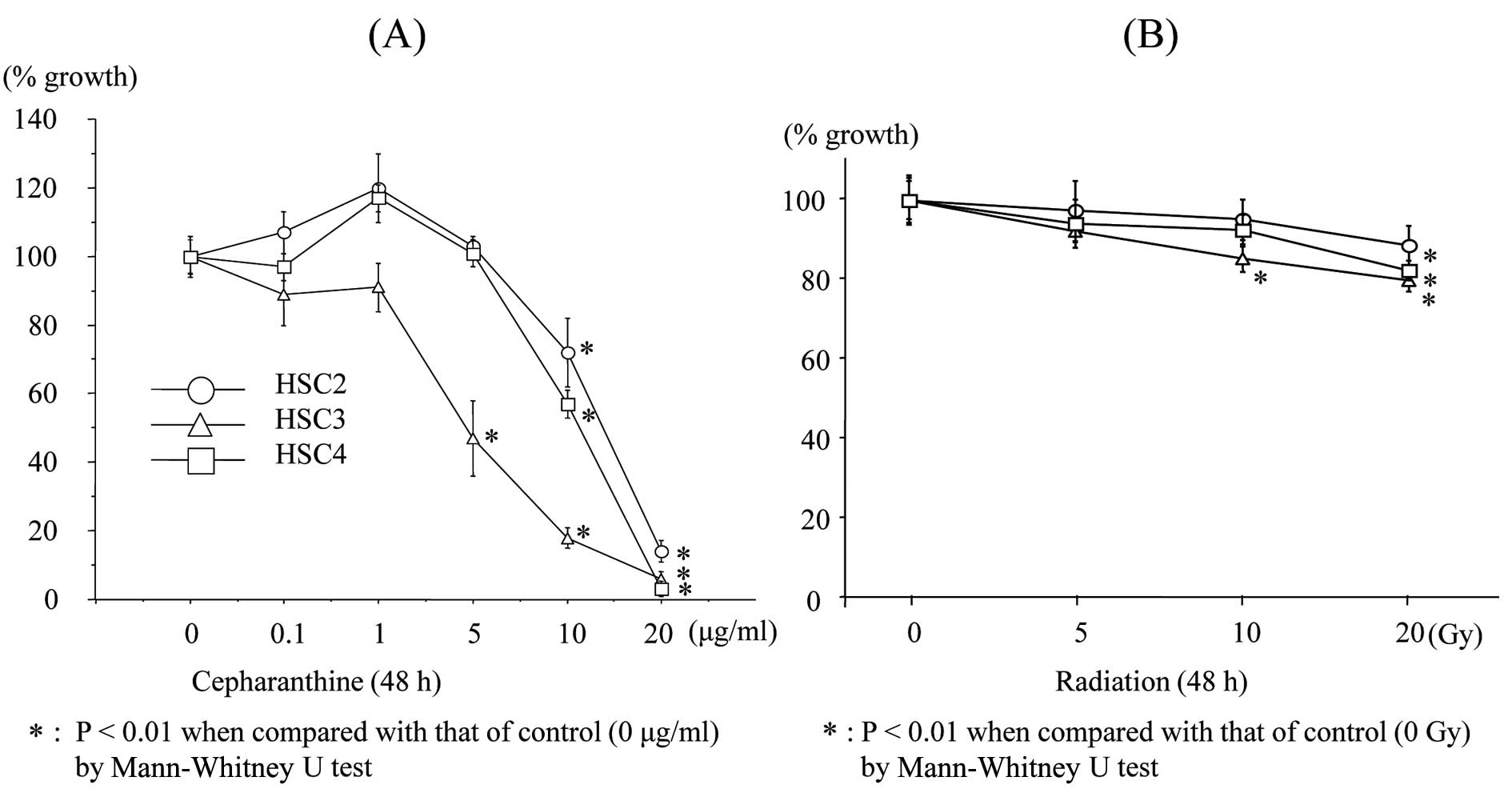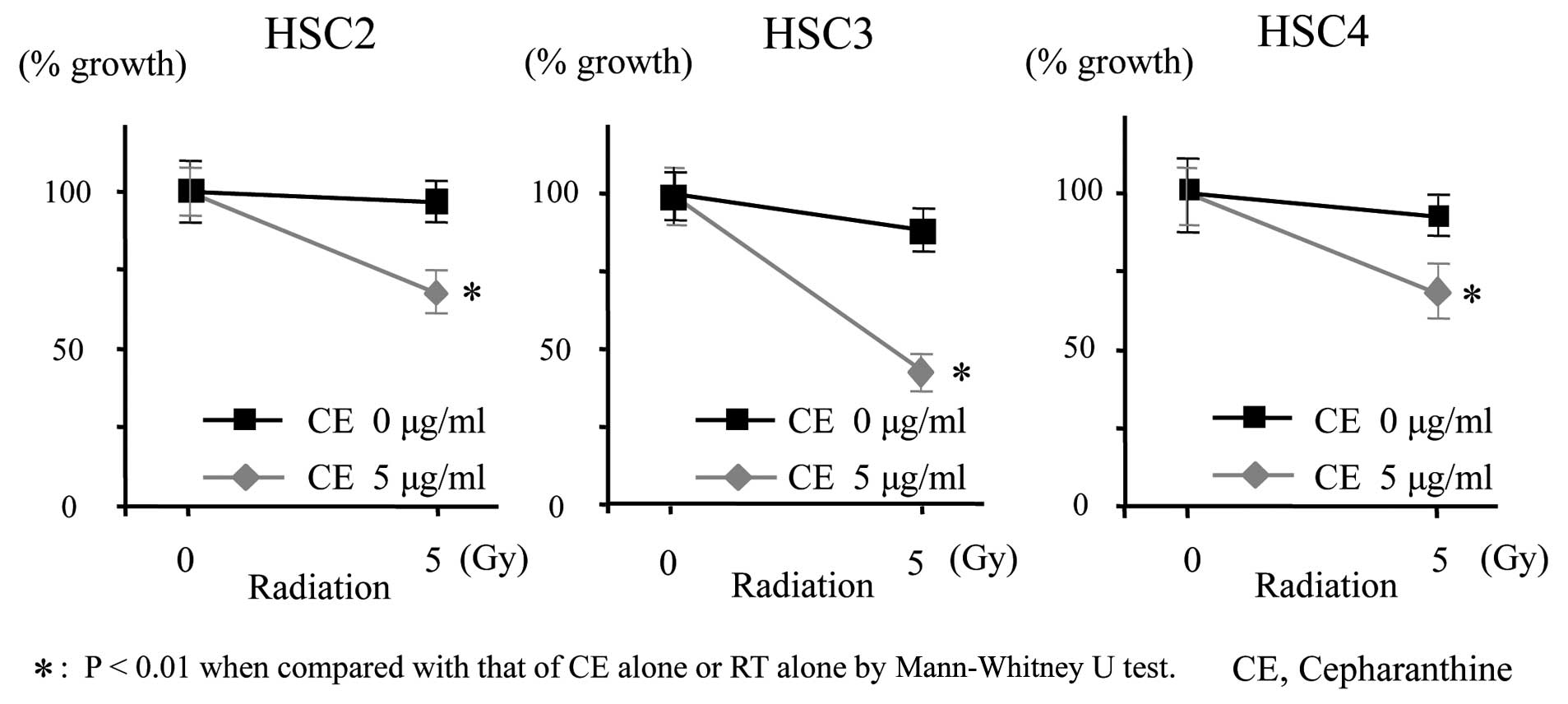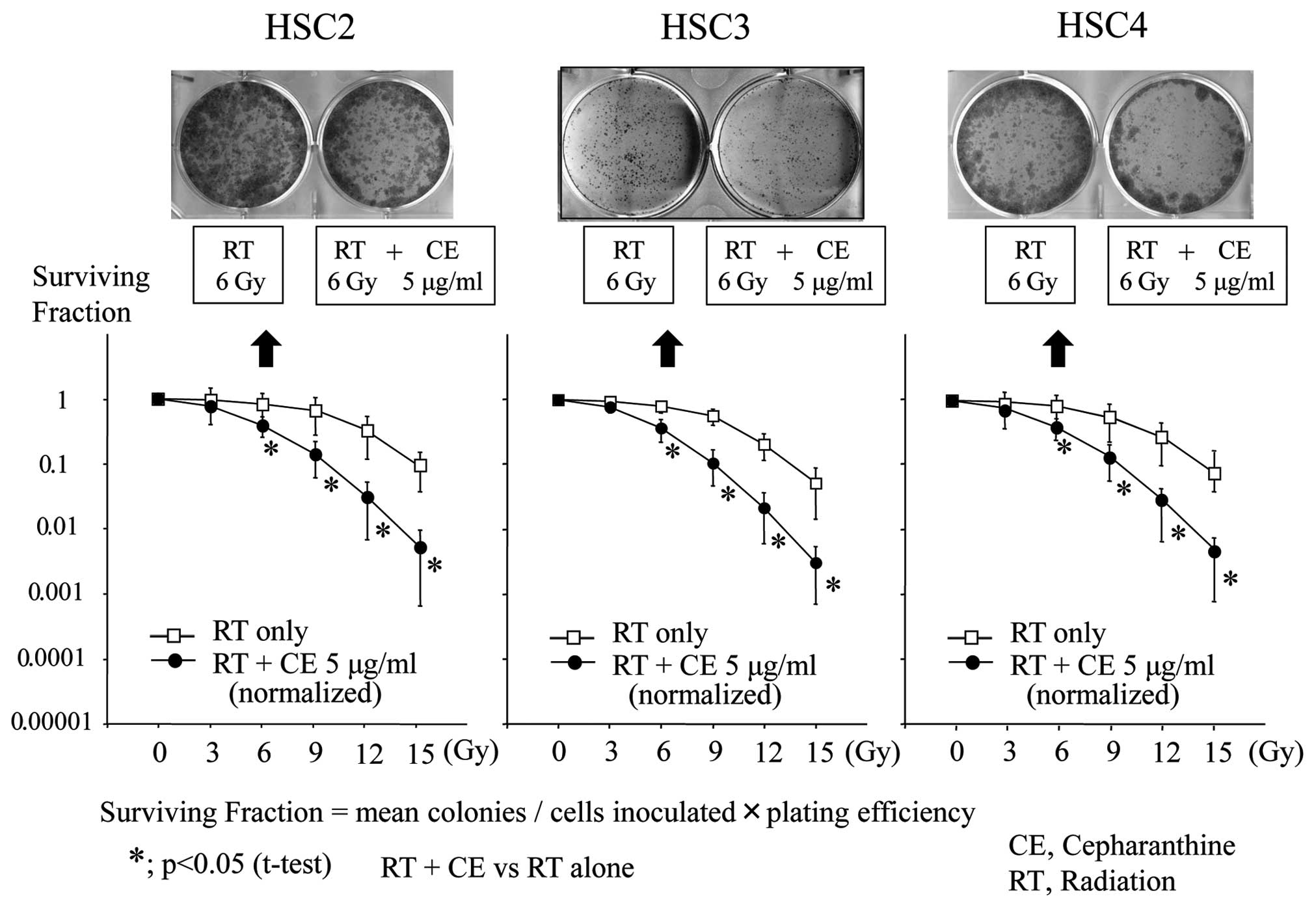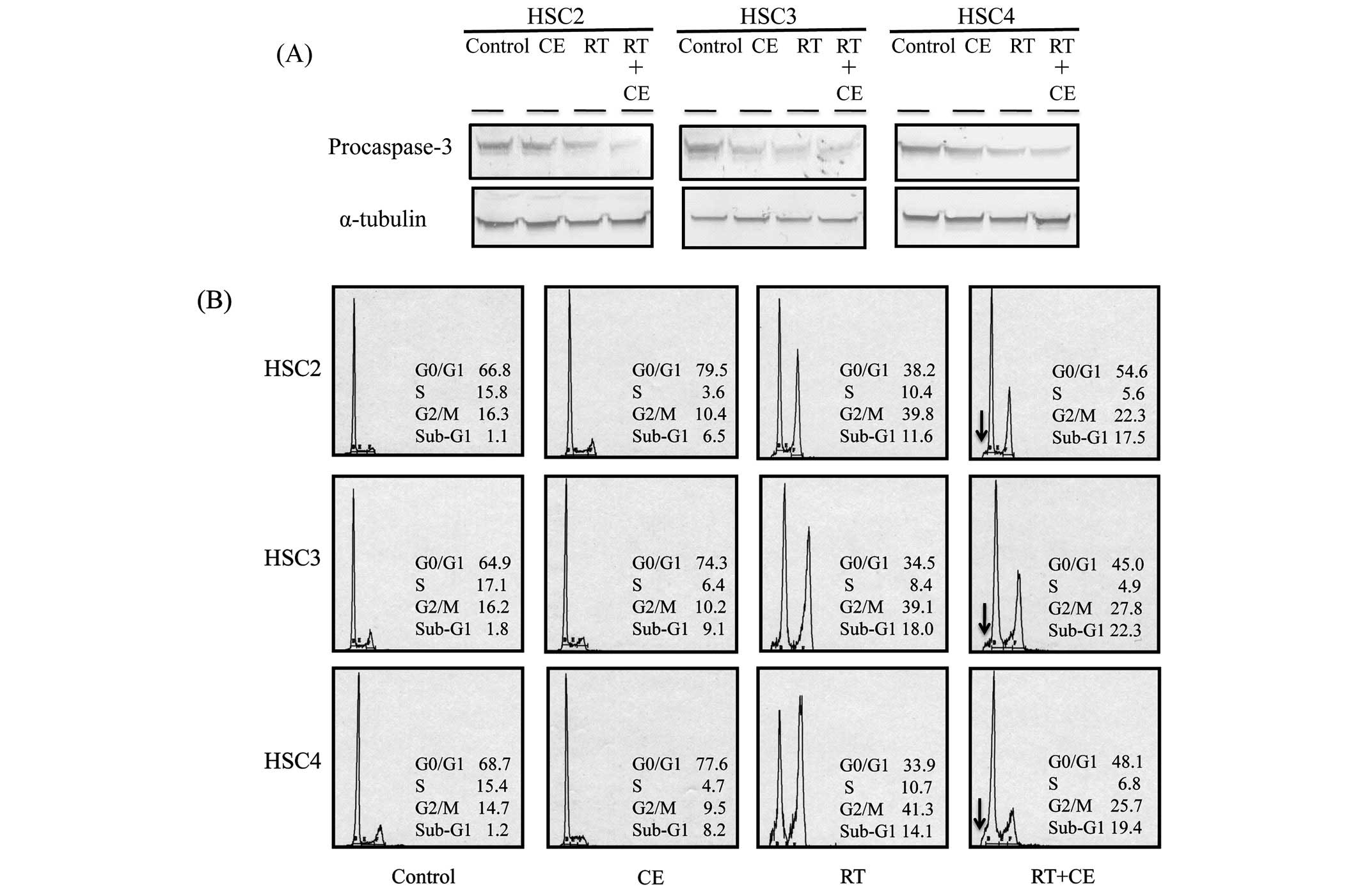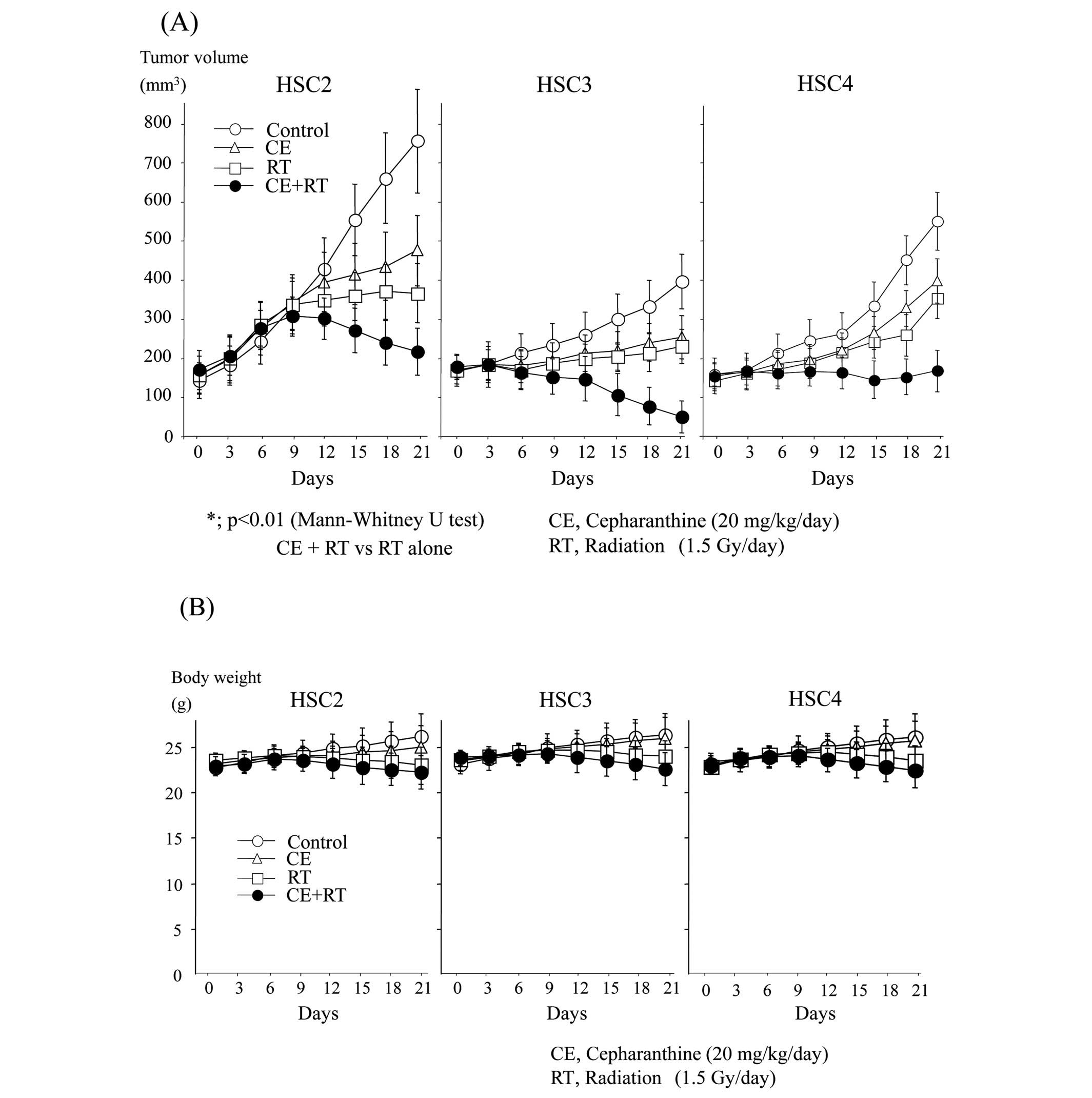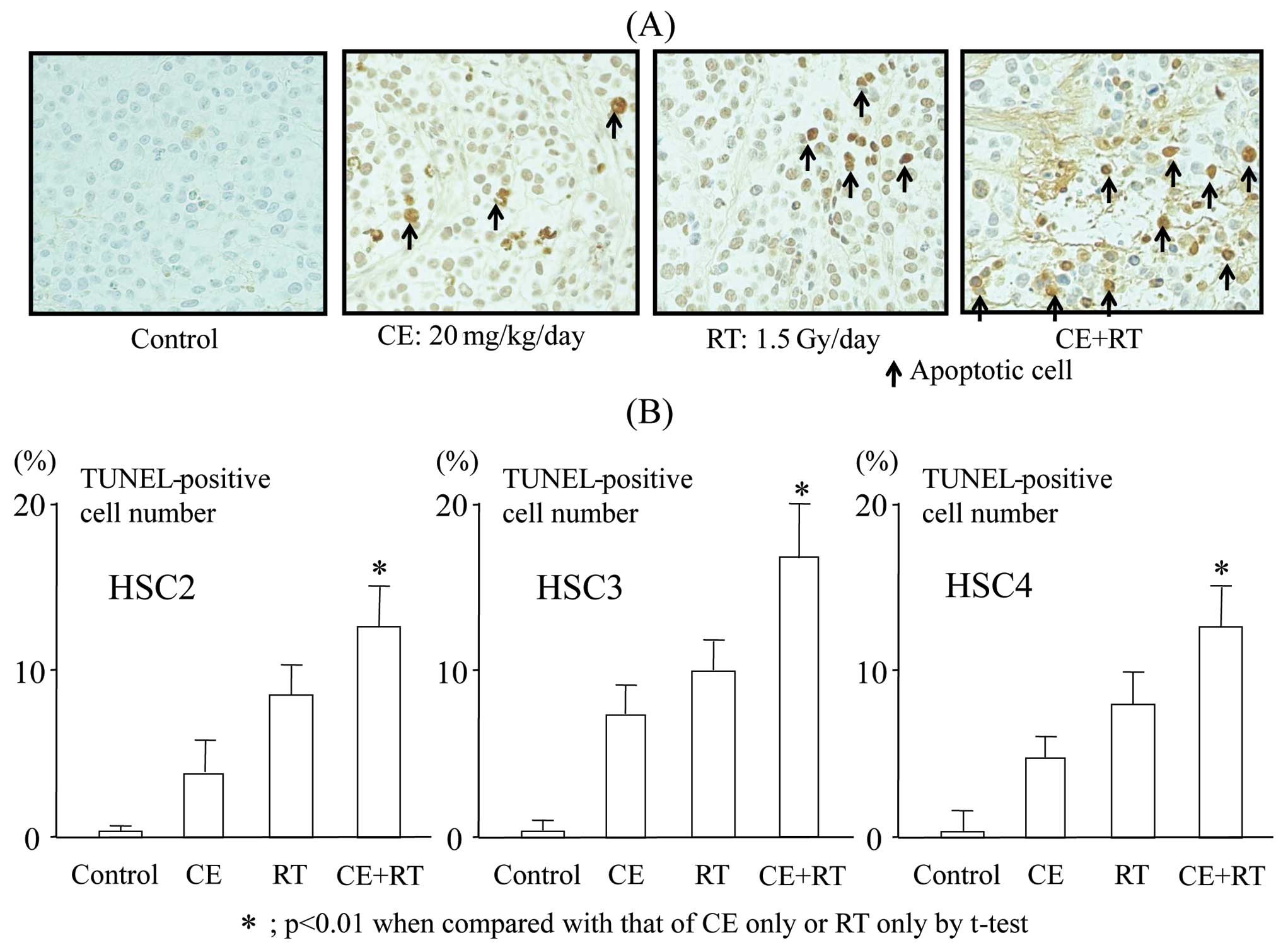Introduction
The incidence of oral squamous cell carcinoma (OSCC)
is increasing gradually, and approximately 300,000 new cases of
oral cancer are estimated worldwide each year (1–3).
OSCC is the most common malignant neoplasm of the oral cavity and
represents approximately 90% of all oral malignancies (4). Radiotherapy as well as surgery have
been used for the curative treatment of OSCC. In particular,
concurrent chemoradiotherapy has mainly been used for patients with
OSCC to preserve oral function. Some patients respond poorly to
radiation even when radiotherapy is combined with anticancer agents
that possess radiosensitizing effects. This has led to the
development of radiosensitizing drugs with relatively few
side-effects.
Cepharanthine is one of the biscoclaurine alkaloids
extracted from Stephania cepharantha Hayata (5), which has been widely used in Japan
for the treatment of a number of acute and chronic diseases, such
as bronchial asthma, alopecia areata and leukopenia during
radiation therapy or anticancer treatment (6). Additionally, it has been reported
that cepharanthine exerts antitumor effects by increasing the
immunological competence of the host (7,8). It
has also been reported that cepharanthine increases the
intracellular accumulation of the anticancer drug, adriamycin, by
inhibiting its efflux from tumor tissue (9), while reducing its intracellular
accumulation in normal tissue (10). Doxorubicin-resistance may be
circumvented by using cepharanthine (11,12).
Therefore, cepharanthine may be useful in cancer chemotherapy. In
addition, cepharanthine has been shown to exert its antitumor
effect by inducing apoptosis in a mouse leukemia cell line
(13), an adenosquamous cell
carcinoma cell line (14) and an
OSCC cell line (15). Recently, we
reported on the anti-angiogenic effect of cepharanthine (16), and the combined effects of
cepharanthine and the oral 5-fluorouracil pro-drug, S-1, against
OSCC (17). However, little is
known about the combined effects of cepharanthine and radiation
against OSCC.
Radiation induces DNA double-strand breaks (DSBs) in
irradiated cells, which may lead to cell killing or tumorigenesis
if the DSBs are not repaired properly. The timely and precise
repair of DSBs are essential for genome maintenance. Cells have 2
major pathways to repair DSBs: non-homologous end-joining (NHEJ)
and homologous recombination (HR) (18). NHEJ involves 4 core factors: Ku
serves as a DSB sensor, DNA-PKcs is a protein kinase, XRCC4/LigIV
is a DNA ligase and XLF bridges the DSB sensing and ligation steps.
These factors assemble on DSBs in a step-by-step manner from Ku to
XLF. XLF has been identified as a new essential factor of NHEJ
(19–21). On the contrary, a number of
proteins (Nbs1-Mre11-Rad50, BRCA1 and Rad51) exhibit local
accumulation after DSB induction in the HR pathway. Rad51 is
thought to be a major protein in HR (22). The inhibition of DNA damage repair
may also enhance tumor radiosensitivity.
In the present study, we examined the
anti-proliferative and apoptosis inducing activity of cepharanthine
in combination with radiation in the 3 OSCC cell lines, HSC2, HSC3
and HSC4. The response of OSCC xenografts in athymic mice to the
combined treatment with radiation and cepharanthine was also
examined. Furthermore, we investigated various potential mechanisms
by which cepharanthine may enhance tumor radiosensitivity.
Materials and methods
Cell lines and culture
The HSC2, HSC3 and HSC4 cell lines were purchased
from Cell Bank, RIKEN BioResource Center (Ibaraki, Japan). Cells
were cultured in Dulbe used for normalization of western blot
analysis cco’s modified Eagle’s medium (DMEM) (Sigma-Aldrich, St.
Louis, MO, USA) supplemented with 10% fetal bovine serum (FBS)
(Invitrogen, Carlsbad, CA, USA), 100 μg/ml streptomycin, 100
U/ml penicillin (Invitrogen) in a humidified atmosphere containing
5% CO2.
Reagent and radiation treatments
For the in vitro assay, cepharanthine was
provided by Kaken Shoyaku Co. Ltd. (Tokyo, Japan). The drug was
easily dissolved in complete culture medium. Cells on the dish were
irradiated with 0–20 Gy using an X-ray irradiator (MBR-1505R2, 150
kV, 5 mA, filter: 1.0 mm aluminum; Hitachi Medico, Tokyo,
Japan).
In vitro cell growth assay
Cells (5×103 cells per well) were seeded
on 96-well plates (Becton-Dickinson Labware, Franklin Lakes, NJ,
USA) in DMEM supplemented with 10% FBS. Twenty-four hours later,
the cells were either treated with cepharanthine (0–20
μg/ml), or were exposed to X-ray irradiation (0–20 Gy), or
both. After 48 h, 3-(4, 5-dimethylthiazol- 2-yl)-2,
5-diphenyltetrazolium bromide (MTT) was added to each well (25
μl/well) and incubated for 4 h. The blue dye absorbed by the
cells was dissolved in dimethyl sulfoxide (100 μl/well), and
the absorbance was measured with a spectrophotometer (BioRad
Laboratories, Hercules, CA, USA) at 490 nm. All assays were run in
triplicate.
Clonogenic survival assay
Log-phase cells were trypsinised, counted, and
plated in triplicate per data point into 6-well plates. Cells were
treated with cepharanthine (5 μg/ml), incubated at 37°C for
1 h before irradiation with X-rays (3, 6, 9, 12, 15 Gy), then
returned to 37°C for 9 days after the medium was changed with 10%
FBS DMEM. Colonies were fixed with 3:1 methanol/acetic acid and
stained with hematoxylin (Muto Chemicals, Tokyo, Japan). Colonies
were counted with the naked eye, with a cut-off of 50 viable cells.
The surviving fraction (SF) was calculated as mean colonies/(cells
inoculated × plating efficiency). Experiments were repeated at
least 3 times. Clonogenic survival curves were then plotted.
Western blot analysis
The control- and cepharanthine (5 μg/ml, 1
h)-treated cells were irradiated (5 Gy). After 30 min or 48-h
incubation, cells were lysed with RIPA buffer (Thermo Scientific,
Rockford, IL, USA). Whole cell lysates were subjected to
electrophoresis on 10% SDS-polyacrylamide gels, and then
transferred to PVDF membranes. The membranes were incubated with
anti-Rad51 rabbit polyclonal, anti-Ku86 rabbit polyclonal,
anti-Ku70 mouse monoclonal, anti-DNA-PKcs mouse monoclonal,
anti-Rad50 mouse monoclonal, anti-XRCC4 rabbit polyclonal, anti-XLF
rabbit polyclonal and anti-caspase-3 mouse monoclonal antibodies
(all from Santa Cruz Biotechnology Inc., Santa Cruz, CA, USA). The
antibodies were detected using a chromogenic immunodetection system
(WesternBreeze; Invitrogen) according to the manufacturer’s
instructions. Anti-α-tubulin monoclonal antibody (Santa Cruz) was
used for the normalization of the proteins from western blot
analysis.
Flow cytometry analysis
The control and cepharanthine (5 μg/ml, 1
h)-treated cells were irradiated (5 Gy). After 48-h incubation, the
attached and floating cells were collected in conical tubes
(Becton-Dickinson). The cells were then fixed with 70% ethanol and
washed with PBS. After treatment with 100 μg/ml of RNase A
(Sigma-Aldrich), the cells were stained with 40 μg/ml
propidium iodine (Molecular Probes, Eugene, OR, USA), and the cell
cycle was analysed by a digital flow cytometry system (Cytomics
FC500; Beckman Coulter, Miami, FL, USA).
Nude mice and breeding
Female athymic nude mice with a
CAnN.Cg-Foxnlnu/CrlCrlj genetic background (CLEA Japan Inc., Tokyo,
Japan) were purchased at 4 weeks of age and kept under sterile
conditions in a pathogen-free environment. The mice were provided
with sterile water and food ad libitum and all manipulations
were carried out aseptically inside a laminar flow hood. The mice
were maintained and handled in accordance with the Guidelines for
Animal Experimentation of Yamaguchi University, Ube, Japan.
In vivo tumor growth assay
The effect of combined cepharanthine treatment and
radiation exposure was assessed by the inoculation of cells into
5-week-old female athymic nude mice. Cells (1×106) were
suspended in 0.1 ml of serum-free medium and injected into the
subcutaneous tissue of mice (average weight, 15.0 g) using a
27-gauge needle. Tumors at the inoculation site were monitored and
measured. When the tumors reached 100–150 mm3 in volume,
the mice were divided into 4 groups, and treated with cepharanthine
and/or exposed to radiation for 3 weeks. Briefly, cepharanthine (20
mg/kg) was injected into the peritumoral tissue for 3 weeks (5
times/week). Tumors on the flanks of mice were irradiated with 1.5
Gy for 3 weeks (5 times/week) using X-ray irradiation (MBR-1505R2,
150 kV, 5 mA; filter, 1.0 mm aluminum). The dose rate was 1.18
Gy/min at a source-skin distance of 56.5 cm. The non-tumor parts of
mice were shielded using lead blocks. The mice in the control group
also received saline (200 μl) by peritumoral injection. The
tumors were measured every 2 days and the tumor volumes were
calculated. At 21 days, mice were sacrificed by cervical
dislocation and the tumors were dissected out, fixed in
neutral-buffered formalin and embedded in paraffin for further
study.
Terminal deoxynucleotidyl transferase
(TdT)-mediated nick end-labeling (TUNEL) assay
To detect apoptotic cells, the ApopTag Plus
peroxidase in situ Apoptosis Detection kit (Intergen Co.,
Purchase, NY, USA) was used. Paraffin sections of tumor
(4-μm-thick) were deparaffinized in xylene and rehydrated in
decreasing concentrations of ethanol. Tissue sections were
incubated in 20 μg/ml proteinase K (Dako, Glostrup, Denmark)
for 15 min. The sections were then rinsed in distilled water,
endogenous peroxidase was blocked by incubating the slides in a 3%
hydrogen peroxide solution for 5 min. After being washed with PBS
(0.05 M phosphate buffer containing 0.145 M sodium chloride, pH
7.4), the sections were incubated with equilibration buffer and
then TdT enzyme in a humidified chamber at 37°C for 60 min. They
were subsequently placed into pre-warmed working strength stop wash
buffer for 10 min. After being rinsed with PBS, the sections were
incubated with anti-digoxigenin-peroxidase conjugate for 30 min.
Peroxidase activity in each section was demonstrated by the
application of diaminobenzidine (Peroxidase Substrate kit; Vector
Laboratories). Hematoxylin was used as the counterstain. At least
1,000 cells were counted under a microscope in several random
fields of each section. The number of apoptotic cells was
calculated by the number of TUNEL-positive cells divided by the
total number of counted cells and the result was expressed as a
percentage.
Statistical analysis
Statistical significance was set at p<0.05.
Statistical analyses were performed using the StatView software
(version 5.0J, SAS Institute Inc., Cary, NC, USA).
Results
Cepharanthine augments cell growth
inhibition by radiation and enhances radiosensitivity in vitro
We examined the effects of cepharanthine and
radiation on the viability of OSCC cells. Cell viability was
evaluated by MTT assay after 48 h of treatment with cepharanthine
or radiation at various cepharanthine concentrations or radiation
doses. HSC3 cell growth decreased at concentrations of 5–20
μg/ml of cepharanthine, and HSC2 and HSC4 cell growth
decreased at 10–20 μg/ml of cepharanthine (Fig. 1A). Radiation inhibited cell growth
in a dose-dependent manner. HSC3 cell growth decreased at dose of
10–20 Gy, and HSC2 and HSC4 cell growth decreased at a dose of 20
Gy (Fig. 1B). Briefly, HSC3 cells
were more sensitive to cepharanthine or radiation than HSC2 and
HSC4 cells. To determine whether the cepharanthine treatment of
OSCC cells enhances the radiation effect, OSCC cells were treated
with cepharanthine (5 μg/ml) and exposed to radiation (5
Gy). The exposure of OSCC cells to radiation with cepharanthine
resulted in a significant growth inhibition when compared to
treatment with cepharanthine or radiation alone (Fig. 2). We also examined whether the
addition of cepharanthine enhances radiosensitivity (mitotic death
by radiation). OSCC cell lines were treated with radiation alone or
in combination with cepharanthine (5 μg/ml). The dose of
radiation required to give an SF of 10% for each cell line was
decreased (p<0.05) in the presence of cepharanthine (HSC2,
14.7–9.5 Gy; HSC3, 13.3–9.0 Gy; HSC4, 14.3–9.7 Gy). Thus, the
addition of cepharanthine enhanced the radiosensitivity of all cell
lines by 1.47- to 1.55-fold (Fig.
3).
Cepharanthine affects the DNA repair
pathway after radiation
To investigate mechanisms by which cepharanthine
exerts its radiosensitizing effect on OSCC cells, the expression of
DNA-DSB repair proteins was examined by western blot analysis
(Fig. 4). To examine the effect of
cepharanthine on the expression of DNA-DSB repair proteins after
radiation, OSCC cells were treated with cepharanthine (5
μg/ml) for 1 h after radiation (5 Gy). The combined
treatment with radiation and cepharanthine reduced the levels of
Rad51, Ku86, Ku70, DNA-PKcs, Rad50, XRCC4 and XLF in each cell.
DNA-DSB repair protein levels were markedly reduced in HSC3 cells
when compared to those in HSC2 or HSC4 cells.
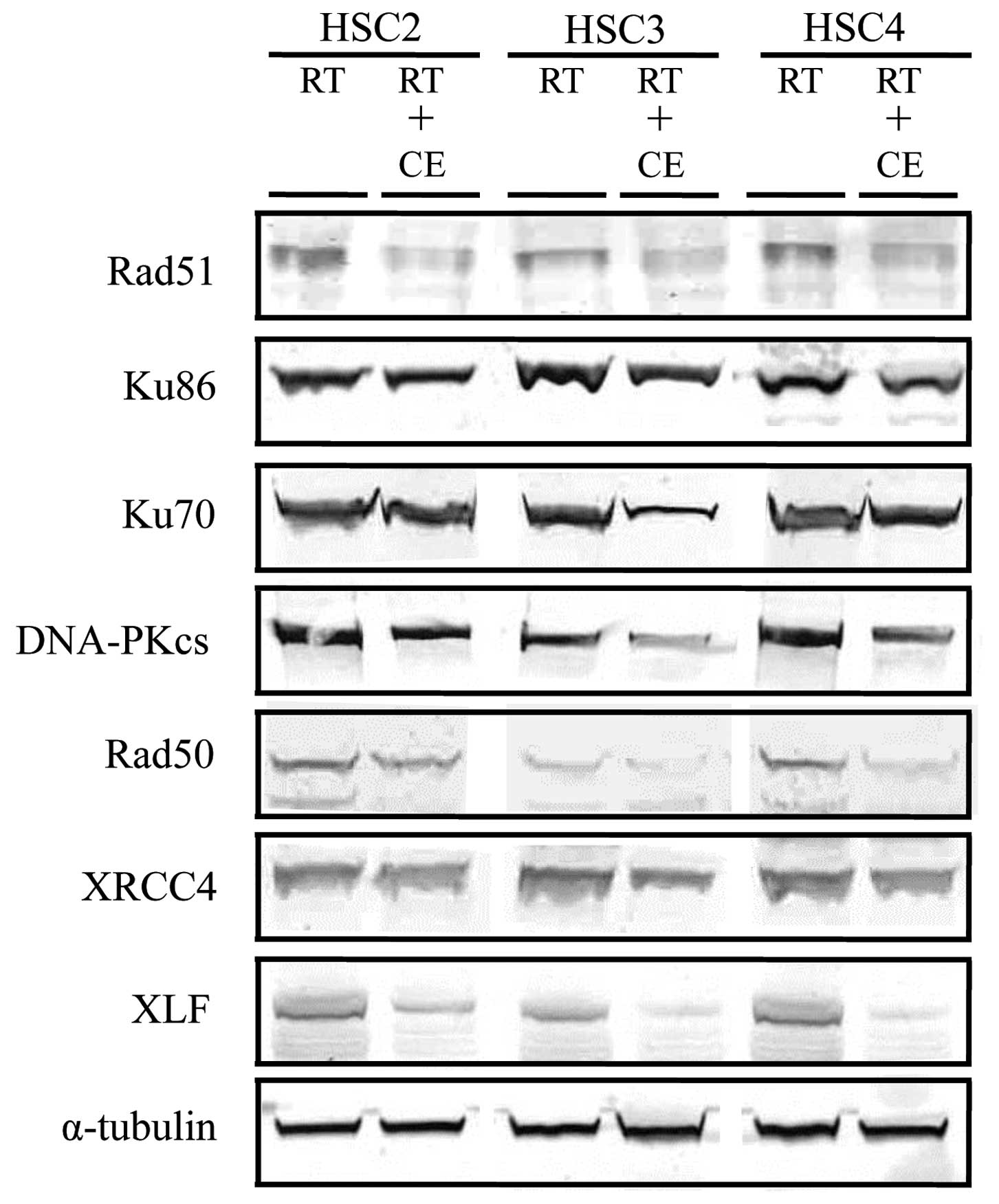 | Figure 4Effect of cepharanthine and radiation
on the expression of DNA-DSB repair proteins in OSCC cells. Control
and cepharanthine (5 μg/ml, 1 h)-treated cells were
irradiated (5 Gy). After 30-min incubation, cells were collected
and lysed. Whole cell lysates were subjected to electrophoresis on
10% SDS-polyacrylamide gels, and then transferred to PVDF
membranes. The membranes were incubated with the antibodies against
DSB repair proteins (Rad51, Ku86, ku70, DNA-PKcs, Rad50, XRCC4 and
XLF) as described in Materials and methods. RT, radiotherapy; CE,
cepharanthine. |
Induction of apoptosis by combined
treatment of cepharanthine and radiation
We then investigated whether the combined effects of
cepharanthine and radiation on in vitro cell growth of OSCC
cells is associated with the induction of apoptosis. Therefore, the
activation of procaspase-3 was examined after treatment with
cepharanthine alone, radiation alone or the combination of both. As
shown by western blot analysis, we observed an enhanced activation
of procaspase-3 in the cells treated with cepharanthine in
combination with radiation when compared to the cells treated with
either reagent alone or no treatment (Fig. 5A). Cell cycle changes associated
with the combined treatment of cepharanthine and radiation in each
cell were analysed using a digital flow cytometry system. We
detected a G1 phase arrest in cepharanthine-treated cells and a
G2/M phase arrest in radiation-treated cells. A sub-G1 peak was
notably high in the cells treated with cepharanthine and radiation,
although a sub-G1 peak was observed in the cepharanthine- and
radiation-treated cells (Fig.
5B).
The effect of combined therapy with
cepharanthine and radiation on tumor growth in vivo in nude
mice
On the basis of the above in vitro findings,
we examined the effects of cepharanthine and radiation on in
vivo tumor growth. Each cell was injected into the backs of
nude mice subcutaneously, and the treatment with cepharanthine
and/or radiation commenced when the tumor volume reached 100–200
mm3. As shown in Fig.
6A, treatment with radiation or cepharanthine alone produced
modest inhibition of tumor growth in HSC2, HSC3 and HSC4 cell
xenografts, and that combined treatment with radiation and
cepharanthine produced a marked inhibition of tumor growth in all
mice.
Systemic therapy with cepharanthine alone, radiation
alone and cepharanthine in combination with radiation resulted in
growth inhibition and tumor regression; tumor volume was reduced
from 765.7 in the controls to 475.3, 371.7 and 226.3 mm3
in the HSC2 cell xenografts (p<0.01) and from 391.6 in the
controls to 248.91, 223.6 and 43.7 mm3 in the HSC3 cell
xenografts (p<0.01), and from 572.6 in the controls to 392.4,
367.0 and 174.2 mm3 in the HSC4 cell xenografts
(p<0.01). During the experimental period, no loss of body weight
was observed in the mice treated with the combined therapy
(Fig. 6B). Furthermore, the
induction of apoptosis was examined in all OSCC tumor xenografts.
Apoptotic cells were examined by TUNEL assay. The apoptotic cells
in the HSC2 tumors are shown in Fig.
7A. The TUNEL-positive cells were significantly increased in
each tumor treated with cepharanthine and radiation when compared
to each tumor treated with either agent alone (Fig. 7B).
Discussion
In this study, we focused on the various biological
and pharmacological activities of cepharanthine. We report that
cepharanthine suppresses tumor growth by inducing cell cycle arrest
through the downregulation of cyclin E and the upregulation of p27
(15) or p21 (14), and by inducing apoptotic effects
through the activation of caspase-9 and caspase-3. Recently, we
reported on the anti-angiogenic effect of cepharanthine (16), and the combined effects of
cepharanthine and the oral 5-fluorouracil pro-drug, S-1, against
OSCC (17). Other studies have
also reported that cepharanthine exerts anti-tumor effects by
inhibiting the activity of P-glycoprotein (23,24),
and regulating the expression of Bcl-2 and Bax protein (25,26).
From these perspectives, cepharanthine should be useful for
anticancer treatment. However, little is known about the detailed
mechanisms of the antitumor activity of cepharanthine in solid
tumors, including OSCC. Many patients with advanced OSCC desire a
treatment other than surgery or functional preservation therapy.
Chemoradiotherapy is then selected as the primary treatment. In
this case, cepharanthine is administered during chemo-radiotherapy
for the treatment of leukopenia, as well as mucositis. However,
little is known about the combined effects of cepharanthine and
radiation against OSCC. In this study, we investigated the combined
effects of cepharanthine and radiation against OSCC.
Cepharanthine or radiation alone was ineffective
against HSC2 and HSC4 cells, while HSC3 cells were more sensitive
to cepharanthine or radiation than HSC2 and HSC4 cells (Fig. 1). The combined effect of
cepharanthine and radiation was also observed in in all 3 cell
lines (Fig. 2). From these
findings, it is evident that cepharanthine can act as a
radiosensitiser. We then investigated whether cepharanthine can
promote the mitotic death of cancer cells by radiation. The
combined treatment of cepharanthine and radiation suppressed the
colony forming capacity of the cancer cells, as opposed to
radiation alone (Fig. 3).
Cepharanthine may be a safe and useful radiosensitiser as it has
little adverse effects clinically. We did not detect any adverse
effects, such as loss of body weight in the tumor-bearing nude mice
treated with cepharanthine alone (Fig.
6B).
Radiosensitisers are thought to increase the
radiosensitivity by inhibiting the repair of radiation-induced DNA
damage. We then examined whether cepharanthine can regulate the
expression of DNA-DSB repair proteins induced by radiation. The
expressions of DSB repair proteins (Rad51, Ku86, Ku70, DNA-PKcs,
Rad50, XRCC4 and XLF) were decreased in OSCC cells treated with
cepharanthine and radiation, compared to the cells treated with
radiation alone. Briefly, the expressions of DNA-DSB repair
proteins related to NHEJ and HR were suppressed by the combined
treatment of cepharanthine and radiation. Of note, the expressions
of DNA-DSB repair proteins (Ku70, DNA-PKcs and XECC4) were markedly
suppressed in the HSC3 cells as opposed to the HSC2 and HSC4 cells.
HSC3 cells may have been more sensitive to cepharanthine and
radiation than HSC2 and HSC4 cells, as the DNA-DSB repair system
was inhibited effectively in the HSC3 cells (Fig. 4). The combined treatment of
cepharanthine and radiation not only inhibited the repair of
radiation-induced DNA damage, but also enhanced radiation-induced
apoptosis in OSCC cells (Fig.
5).
Similarly, the combination of cepharanthine and
radiation was more effective against human tumor xenografts than
either agent separately (Fig. 6A).
Also, the main mechanism of anti-tumor activity was thought to be
the augmentation of apoptosis (Fig.
7). Moreover, adverse effects including loss of body weight
were not detected in the tumor-bearing nude mice treated with
cepharanthine and radiation (Fig.
6B). These findings suggest that the combination therapy of
cepharanthine and radiation is safe for the body. Suitable doses of
cepharanthine and radiation for combination therapy must be
developed.
In conclusion, cepharanthine enhances the effects of
radiation both in vitro and in vivo in human OSCC
models. This study also shows that there may be an advantage to
using both agents together when compared to either agent
separately. These preclinical data show that cepharanthine may have
clinical utility in combination with radiotherapy against OSCC.
Acknowledgements
This study was supported in part by a
Grant-in-Aid from the Japanese Ministry of Education, Science and
Culture.
References
|
1
|
Rautava J, Luukkaa M, Heikinheimo K, Alin
J, Grenman R and Happonen RP: Squamous cell carcinomas arising from
different types of oral epithelia differ in their tumor and patient
characteristics and survival. Oral Oncol. 43:911–919. 2007.
View Article : Google Scholar : PubMed/NCBI
|
|
2
|
Funk GF, Karnell LH, Robinson RA, Zhen WK,
Trask DK and Hoffman HT: Presentation, treatment, and outcome of
oral cavity cancer: a national cancer data base report. Head Neck.
24:165–180. 2002. View Article : Google Scholar : PubMed/NCBI
|
|
3
|
Mehrotra R, Singh MK, Pandya S and Singh
M: The use of an oral brush biopsy without computer-assisted
anaylsis in the oral lesions: a study of 94 patients. Oral Surg
Oral Med Oral Pathol Oral Radiol Endod. 106:246–253. 2008.
View Article : Google Scholar : PubMed/NCBI
|
|
4
|
Lawoyin JO, Lawoyin DO and Aderinokun G:
Intra-oral squamous cell carcinoma in Ibadan: a review of 90 cases.
Afr J Med Med Sci. 26:187–188. 1997.PubMed/NCBI
|
|
5
|
Tomita M, Fujitani K and Aoyagi Y:
Synthesis of dl-cepharanthine. Tetrahedron Lett. 13:1201–1206.
1967. View Article : Google Scholar
|
|
6
|
Saito R, Tsuchiya S, Ishizuka T, Fueki N,
Ezawa K, Minato K, Nakano H, Takise A, Kurihara M and Fueki R:
Clinical effects of cepharanthine (Ceph.) on leukopenia by
chemotherapy in lung cancer patients. Nihon Gan Chiryo Gakkai Shi.
24:2587–2593. 1989.PubMed/NCBI
|
|
7
|
Ono M: Antitumor effect of cepharanthine:
activation of regional lymph node lymphocytes by intratumoral
administration. Clin Immunol. 19:1061–1064. 1987.
|
|
8
|
Morioka S, Ono M, Tanaka N and Orita K:
Synergistic activation of rat alveolar macrophages by cepharanthine
and OK-432. Gan To Kagaku Ryoho. 12:1470–1475. 1985.(In
Japanese).
|
|
9
|
Asaumi J, Kawasaki S, Nishikawa K, Kuroda
M and Hiraki Y: Effects of hyperthermia and cepharanthine on
adriamycin accumulation with change in extracellular pH. Int J
Hyperthermia. 11:27–35. 1995. View Article : Google Scholar : PubMed/NCBI
|
|
10
|
Nishikawa K, Asaumi J, Kawasaki S, Kuroda
M, Takeda Y and Hiraki Y: Influence of cepharanthine on the
intracelluar accumulation of adriamycin in normal liver cells and
spleen cells of mice in vitro and in vivo. Anticancer Res.
17:3617–22. 1997.PubMed/NCBI
|
|
11
|
Hotta T, Tanimura H, Yamaue H, Iwahashi M,
Tani M, Tsunoda T, Tamai M, Noguchi K, Mizobata S, Arii K and
Terasawa H: Modulation of multidrug resistance by cepharanthine in
fresh human gastrointestinal tumor cells. Oncology. 54:153–157.
1997. View Article : Google Scholar : PubMed/NCBI
|
|
12
|
Hotta T, Tanimura H, Yamaue H, Iwahashi M,
Tani M, Tsunoda T, Noguchi K, Mizobata S and Terasawa H:
Synergistic effects of tamoxifen and cepharanthine for
circumventing the multidrug resistance. Cancer Lett. 107:117–123.
1996. View Article : Google Scholar : PubMed/NCBI
|
|
13
|
Furusawa S, Wu J, Fujimura T, Nakano S,
Nemoto S, Takayanagi M, Sasaki K and Takayanagi Y: Cepharanthine
inhibits proliferation of cancer cells by inducing apoptosis.
Methods Find Exp Clin Pharmacol. 20:87–97. 1998. View Article : Google Scholar : PubMed/NCBI
|
|
14
|
Harada K, Bando T, Yoshida H and Sato M:
Characteristics of antitumour activity of cepharanthin against a
human adenosquamous cell carcinoma cell line. Oral Oncol.
37:643–651. 2001. View Article : Google Scholar : PubMed/NCBI
|
|
15
|
Harada K, Supriatno, Yamamoto S, Kawaguchi
S, Yoshida H and Sato M: Cepharanthine exerts antitumor activity on
oral squamous cell carcinoma cell lines by induction of p27Kip1.
Anticancer Res. 23:1441–1448. 2003.PubMed/NCBI
|
|
16
|
Harada K, Ferdous T, Itashiki Y, Takii M,
Mano T, Mori Y and Ueyama Y: Cepharanthine inhibits angiogenesis
and tumorigenicity of human oral squamous cell carcinoma cells by
suppressing expression of vascular endothelial growth factor and
interleukin-8. Int J Oncol. 35:1025–1035. 2009. View Article : Google Scholar
|
|
17
|
Harada K, Ferdous T, Itashiki Y, Takii M,
Mano T, Mori Y and Ueyama Y: Effects of cepharanthine alone and in
combination with fluoropyrimidine anticancer agent, S-1, on tumor
growth of human oral squamous cell carcinoma xenografts in nude
mice. Anticancer Res. 29:1263–1270. 2009.
|
|
18
|
Burma S, Chen BPC and Chen DJ: Role of
non- homologous end joining (NHEJ) in maintaining genomic
integrity. DNA Repair (Amst). 5:1042–1048. 2006. View Article : Google Scholar : PubMed/NCBI
|
|
19
|
Buck D, Malivert L, de Chasseval R,
Barraud A, Fondaneche MC, Sanal O, Plebani A, Stephan JL, Hufnagel
M, le Deist F, Fischer A, Durandy A, de Villartay JP and Revy P:
Cernunnos, a novel nonhomologous end-joining factor, is mutated in
human immunodeficiency with microcephaly. Cell. 124:287–299. 2006.
View Article : Google Scholar : PubMed/NCBI
|
|
20
|
Ahnesorg P, Smith P and Jackson SP: XLF
interacts with the XRCC4-DNA ligase IV complex to promote DNA
nonhomologous end-joining. Cell. 124:301–313. 2006. View Article : Google Scholar : PubMed/NCBI
|
|
21
|
Callebaut I, Malivert L, Fischer A, et al:
Cernunnos interacts with the XRCC4 × DNA-ligase IV complex and is
homologous to the yeast nonhomologous end-joining factor Nej1. J
Biol Chem. 281:13857–13860. 2006.
|
|
22
|
O’Regan P, Wilson C, Townsend S and
Thacker J: XRCC2 is a nuclear RAD51-like protein required for
damage-dependent RAD51 focus formation without the need for ATP
binding. J Biol Chem. 276:22148–22153. 2001.PubMed/NCBI
|
|
23
|
Nakajima A, Yamamoto Y, Taura K, et al:
Beneficial effect of cepharanthine on overcoming drug-resistance of
hepatocellular carcinoma. Int J Oncol. 24:635–645. 2004.PubMed/NCBI
|
|
24
|
Ikeda R, Che XF, Yamaguchi T, et al:
Cepharanthine potently enhances the sensitivity of anticancer
agents in K562 cells. Cancer Sci. 96:372–376. 2005. View Article : Google Scholar : PubMed/NCBI
|
|
25
|
Biswas KK, Tancharoen S, Sarker KP,
Kawahara K, Hashiguchi T and Maruyama I: Cepharanthine triggers
apoptosis in a human hepatocellular carcinoma cell line (HuH-7)
through the activation of JNK1/2 and the downregulation of Akt.
FEBS Lett. 580:703–710. 2006. View Article : Google Scholar : PubMed/NCBI
|
|
26
|
Kikukawa Y, Okuno Y, Tatetsu H, et al:
Induction of cell cycle arrest and apoptosis in myeloma cells by
cepharanthine, a biscoclaurine alkaloid. Int J Oncol. 33:807–814.
2008.PubMed/NCBI
|















